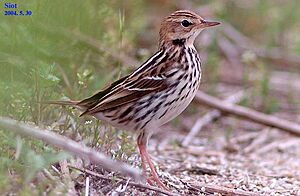Pechora pipit facts for kids
Quick facts for kids Pechora pipit |
|
|---|---|
 |
|
| Conservation status | |
| Scientific classification |
The Pechora pipit (Anthus gustavi) is a small passerine bird. It lives and breeds in the cold, open lands (tundra) of eastern Asia, near rivers. You can find it from the Pechora River in Russia all the way to the Chukchi Peninsula. It also breeds in Kamchatka and the Commander Islands. This bird is a long-distance traveler! In winter, it flies all the way to Indonesia. Sometimes, in September or October, you might even spot a Pechora pipit in western Europe, but that's quite rare. A scientist named Robert Swinhoe first described this bird in 1863.
Contents
Meet the Pechora Pipit!
The Pechora pipit is a small bird. It looks a bit like the red-throated pipit, especially when it's not breeding. This bird has many brown streaks on its back. It also has whitish stripes on its back, near its wings. Its belly is white with black marks, and its chest is a buff (light yellowish-brown) color.
You can tell it apart from the red-throated pipit in a few ways. The Pechora pipit has a stronger beak. Its white stripes on its back are brighter. Also, there's a clear difference between its buff chest and its white belly.
How Does it Behave?
This bird likes to creep and hide in tall grass. It doesn't like to fly, even if something disturbs it. Its call sounds like an electric zip. While bird calls often help identify birds, the Pechora pipit doesn't call as much as other pipits. This, along with its habit of hiding, makes it hard to find and identify. It's especially tricky when they are not in their breeding areas in the Arctic.
One of the best places in western Europe to see this rare bird is Fair Isle. This small island is part of Shetland in Scotland. Because there isn't much cover on the island, it's easier to spot birds that like to hide.
Where Does the Pechora Pipit Live and What Does it Eat?
Pechora pipits build their nests on the ground. They usually lay four or five eggs. Their favorite places to breed are damp tundra, open forests, or marshy areas. Like other pipits, this bird is an insectivore. This means it mostly eats insects.
Where Does its Name Come From?
The first part of the bird's scientific name, Anthus, comes from Latin. It was the name for a small grassland bird. The second part, gustavi, honors a Dutch scientist named Gustaaf Schlegel.
The English name, Pechora pipit, comes from the Pechora River. This river is in northwest Russia, where the bird lives.


